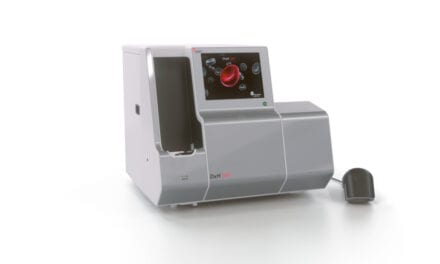Ad Astra Diagnostics (AAD), a developer of rapid diagnostic systems, has received 510(k) clearance from the U.S. Food and Drug Administration (FDA) for its QScout rapid-result hematology system, which provides fast, point-of-care white blood cell counts (WBCs), neutrophil-to-lymphocyte ratio, and differentiates the number and percent of five types of mature WBCs as well as immature granulocytes, according to the company.
“Achieving 510(k) clearance for the QScout platform is a momentous step for our AAD team, and we believe it will be the first of many positive interactions with the FDA,” says Joy Parr Drach, AAD’s president & CEO. “In developing QScout, we aim to enable and democratize rapid, point-of-care decision-making, and we are confident that its simple, easy-to-use, rugged, no maintenance design has the potential to be an invaluable tool in a variety of healthcare settings.”
Further reading: May/June 2023 Tech Guide: Hematology & Coag Analyzers
QScout is a hematology platform designed for simple, fast operation at the point-of-care. It provides lab-grade, patient-side results that caregivers use to screen for health conditions including infection, leukemia, and other blood-related cancers, allergies, and many more. Elevated levels of IGs have been shown to differentiate sepsis earlier than commonly used measures like lactate and procalcitonin(1). Additionally, NLR is an increasingly important predictor of poor health outcomes that gained greater use during the pandemic. Development of the patent-protected QScout technology platform has its origins in the rugged and unpredictable livestock care setting.
“By quickly providing vital metrics such as a WBC count with differential, IGs, and NLR, QScout has the potential to deliver life-saving information to millions of people working in even the most urgent emergency and intensive care settings where every minute matters,” says Ted Glynn, MD, vice president, Medical Education and Research, Sparrow Health System. “Sepsis is the leading global killer, which is why I am excited to see this important regulatory achievement from our partners and colleagues at AAD. Delivering these critically informative diagnostic measures in close to real-time offers the potential to transform patient care.”
To run the test, whole blood is added to a QScout RLD test, which contains a dried reagent that stains cells. When the test is inserted in the QScout Lab analyzer, an optical system takes images, and an algorithm identifies the cells in real time. Results are displayed in about two minutes.
“QScout uses a cutting-edge imaging-based system not prone to the challenges of flow cytometry, which means that cells are examined directly by an AI-trained system instead of indirect measures like light scatter or electrical resistance,” says Jasper Pollard, chief technology officer, Ad Astra Diagnostics. “With this 510(k) clearance, we move closer to bringing our innovative diagnostic platform to various point-of-care settings, where faster results can improve health outcomes, and to labs, where it can improve efficiency and operations.”
Testing to demonstrate the equivalence of QScout RLD to a central lab hematology analyzer was performed at a central lab and at multiple point-of-care locations, which included a cancer treatment center, community health center, emergency department, bedside with in-patients in the ICU, hematology-oncology wards, and a phlebotomy draw center.
This project has been funded in part with federal funds from the U.S. Department of Health and Human Services; Administration for Strategic Preparedness and Response; Biomedical Advanced Research and Development Authority, under contract number 75A50121C00089 as part of BARDA’s Host Based Diagnostics Program.
References:
1.Bhansaly P, Mehta S, Sharma N, Gupta E, Mehta S, Gupta S. Evaluation of Immature Granulocyte Count as the Earliest Biomarker for Sepsis. Indian J Crit Care Med 2022;26(2):216–223.
Photo: Ad Astra




